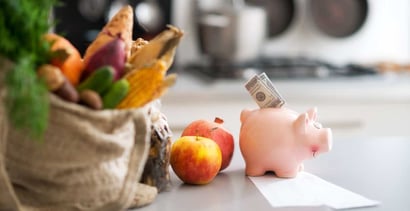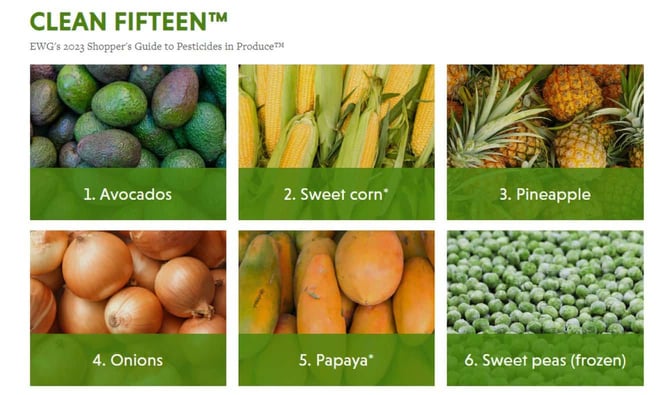
March is National Nutrition Month and a good time to think about how you can add more healthy foods to your diet. But unfortunately, grocery prices have remained stubbornly high even as inflation has begun to ease. As a result, many Americans who are struggling to get by each month and drowning in debt are unable to improve their eating habits, especially given the higher costs of healthy groceries.
The good news is there are small things you can do to reduce your grocery purchases — even on healthier foods — whether you’re looking to add more leafy greens, lean meats, fish, or organic grains to your meals. Just follow these seven simple steps to save money on your next grocery haul.
1. Learn to Love Meal Planning
According to a study by OnePoll for HelloFresh, the average American throws away $3,276 worth of groceries annually. Reigning in this waste is the key to reducing food costs and will allow you to put more of your grocery spending toward healthier options. And, the best way to do this is to start meal planning.
Begin by figuring out which days of the week you will be eating at home, and then choose recipes that your family will enjoy. Tap into apps like Eat Together for help planning healthy, affordable, and easy-to-cook meals.
2. Compare Sales Among Stores
Once you know which ingredients you need to buy for the week, cross reference what you already have at home in your pantry, fridge, and freezer so you don’t double up. Then, compare grocery circulars to see which stores have the best deals for the items on your list.

Apps like Flipp aggregate grocery ads based on your location, so you can quickly and easily compare prices right from home or the on-go, taking the guesswork out of where to shop when it comes to getting the best deals.
3. Buy the Store Brand
Store brands have come a long way over the last decade, rivaling national name brands for taste and quality and offering organic and gluten-free options. And, considering many generic and store brands are manufactured in the same facilities as name-brand alternatives — but cost around 30% less — you should give them a try to stretch your budget without sacrificing.
For those who are hesitant to divert from a favorite name-brand food, just compare ingredients with the store brand option to see if it matches up and give it a taste test at home. Many grocery stores will accept returns if you’re unhappy with the quality of their product. And, in some cases, you may discover that it’s just as good or better while helping you save big.
4. Snag Manager Markdowns
Healthy foods have seen some of the highest price hikes in recent years, according to the USDA Economic Research Service. But even though food costs have skyrocketed, there are still ways to save, especially when you look for fresh foods that are about to expire, known as “manager markdowns.”
Fresh foods such as meat, chicken, fish, dairy products, and even produce nearing their “best-by date” or “sell-by date” are often marked down and can offer savings of up to 70%.

These deals are a great way to incorporate healthy foods into your meal plan without spending a lot. Just make sure you quickly cook or freeze these foods to avoid spoiling.
5. Limit Bulk Purchases of Fresh Foods
When it comes to fresh fruit and vegetables, buying in bulk may seem like the better financial choice thanks to a lower per-unit cost. However, it’s important to consider how much produce could end up in the trash because it’s gone bad before you’ve had a chance to eat it all.
If this occurs often, it’s time to scale back on how much produce you buy in bulk. In most cases, you’re better off buying smaller amounts of fresh produce but shopping more often to limit waste and reduce overall spending.
Another option is to freeze fruits and vegetables, so you’ll always have something on hand for a last-minute smoothie, stir fry, or omelet without worrying about it going bad.
6. Know Which Organics to Skip
Organic produce, although pricey, can keep you and your family safe from harmful pesticides. But purchasing every type of organic fruit and vegetable available is a waste of money. That’s because certain fruits and vegetables, referred to as “The Clean 15,” are not affected by chemicals.

According to The Environmental Working Group, 15 fruits and vegetables, including bananas, avocados, and mangos, are perfectly safe to consume in the non-organic version, thanks to tough, inedible peels that pesticides can’t penetrate. Review this list and save by choosing non-organic for these produce items.
7. Tap into Grocery Savings Apps
Your mobile phone can go a long way in stretching your dollars on healthy foods. Always tap into the grocery store’s app to access digital coupons you can scan for instant savings at checkout. Some stores even offer deals for money off your total purchase, especially for new members. In fact, the Albertson’s For U Rewards app offers $5 off $25 for new users, and Target Circle often features a variety of discounts on grocery goods when you use their app.
Other rewards apps like Fetch will give you cash back when you scan pictures of your grocery receipts, and the Coupon Cabin app can help you score a wide variety of grocery deals and even more cash back.




